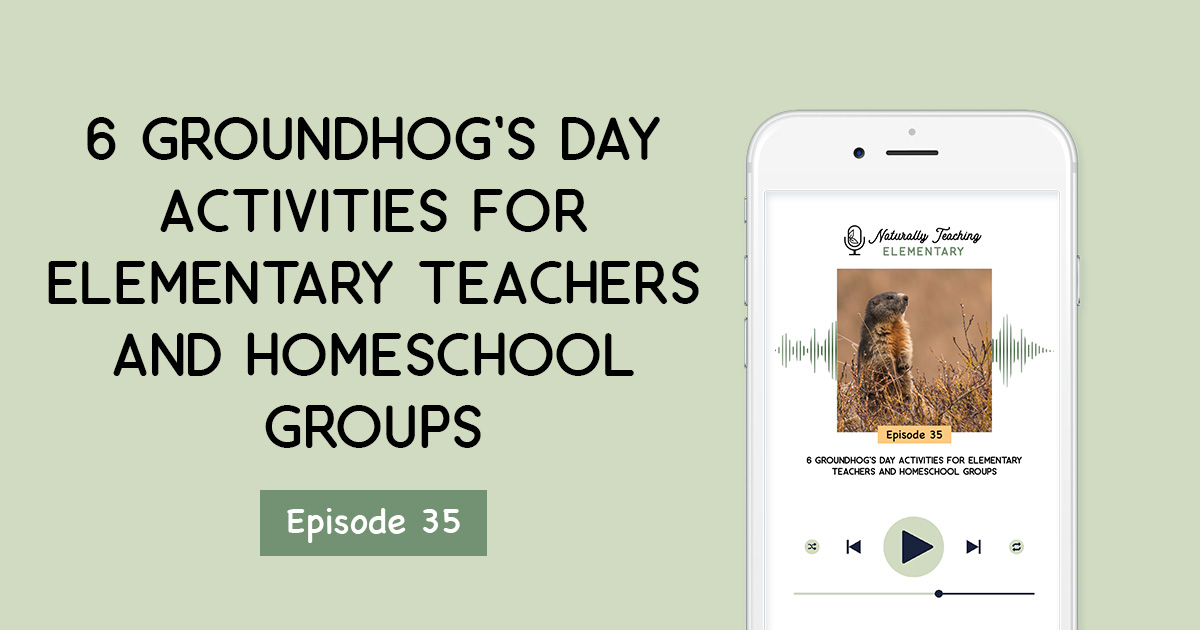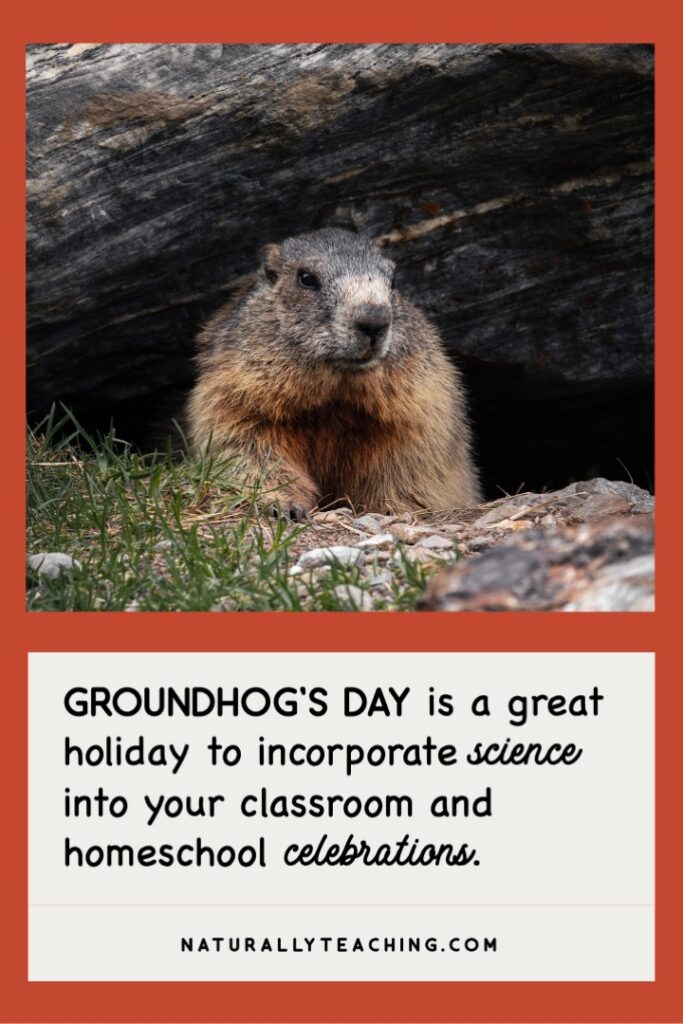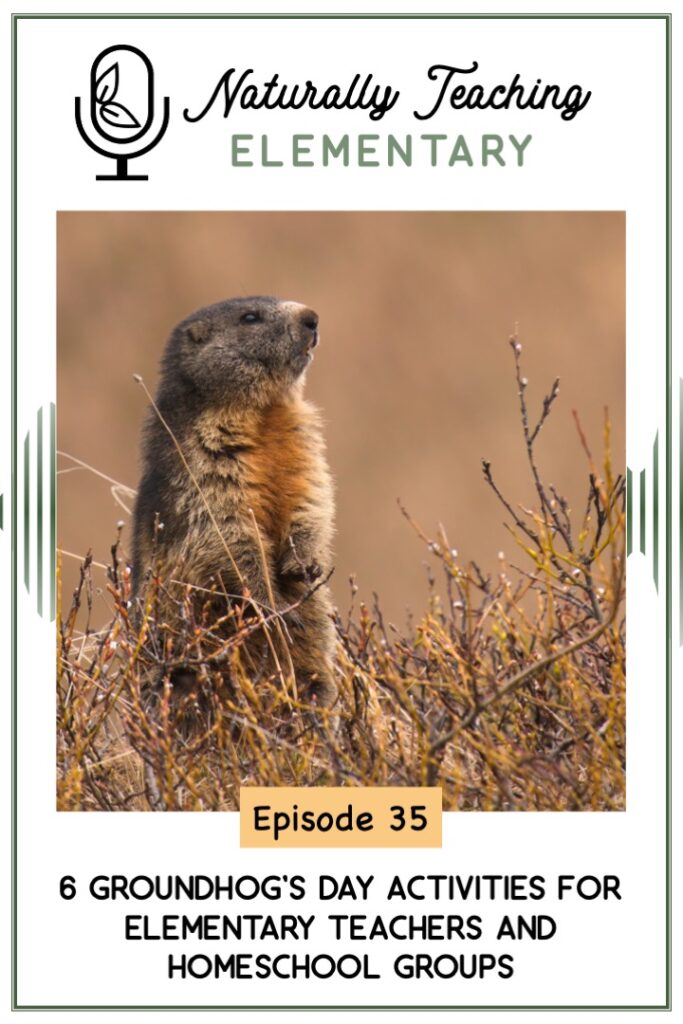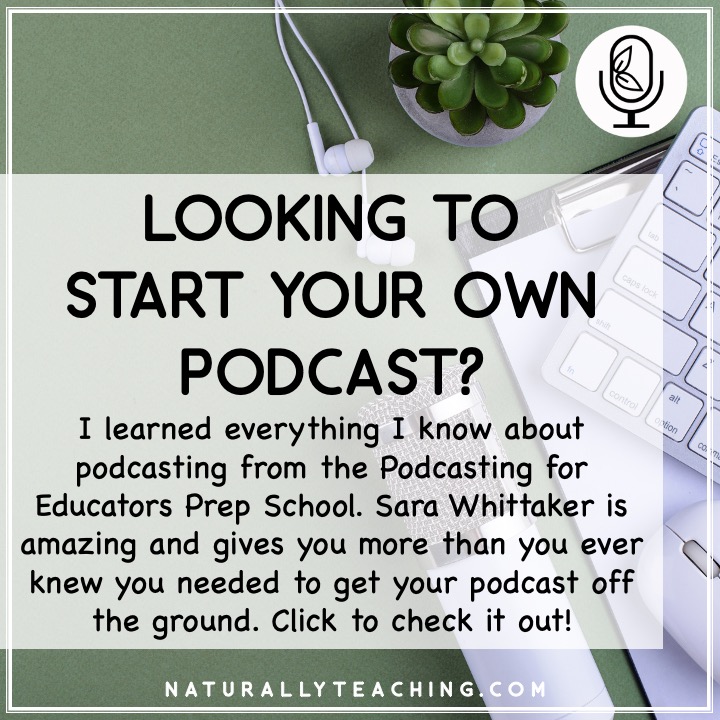Science
Frogs and Toads Together: Why do Amphibians Group Up?April 11, 2025


Groundhog’s Day is an underrated holiday with tremendous potential for both fun and the integration of science curriculum. Not only can you talk about weather forecasting, but you can also discuss shadows, hibernation, and squirrels in engaging and meaningful ways.
In this episode, we’ll talk about 6 Groundhog’s activities that are paired with Next Generation Science Standards for grades K-5. I’ll share the standard that inspired the activity, how the activity relates to Groundhog’s Day and descriptions of how to use the activity in your classroom or at home.
The following standards are paired with Groundhog’s Day activities in the episode:
Did you know that Groundhogs are the same animal as Woodchucks? They are also called Whistlepigs and marmots depending on the region you’re from. They are also part of the squirrel family; they are a kind of ground squirrel like chipmunks. Groundhogs are also true hibernators meaning that they enter a sleep-like state from fall until spring in order to survive winter. Use these fun facts while you’re enjoying Groundhog’s Day activities this year!

Teaching elementary-aged children is a rewarding experience, but as educators and parents, finding the time and resources to create engaging lessons can be a challenge. That's where this podcast comes in. Welcome to Naturally Teaching Elementary.
I'm Victoria Zablocki, a certified elementary teacher turned outdoor educator. With over a decade of experience coaching teachers on effective teaching methods, I'm passionate about teaching the whole child with authentic and place-based experiences in school and home settings. Join me as we explore strategies for teaching with practical teaching tips, insightful interviews, picture book reviews, and more. So let's grow together.
All right, everybody, welcome back to the Naturally Teaching Elementary podcast. My name is Victoria Zablocki and I'm your host.
So Groundhog's Day is coming up and it is a fantastic opportunity to connect your science curriculum with a fun holiday. Groundhog's Day is synonymous with weather forecasting, but it can also be a great way to encourage exploration of shadows, hibernation and squirrels.
[1:01]
But before we get into some Groundhog's Day activities, I wanted to share a nature note with you with some interesting information about groundhogs that you may or may not know.
So did you know that groundhogs are actually the same thing as woodchucks? They're also called whistle pigs and marmots, depending on the region that you're in. They are also part of the squirrel family.
Technically, they're a ground squirrel similar to a chipmunk who burrows underground versus a tree squirrel that lives in trees. They're also true hibernators, meaning that they spend fall fattening up and then they reduce their metabolism so much that they appear to be dead. Then they spend all winter in this sleep-like state, waking up in the spring when the days are longer and green plants start growing.
That means that Punxsutawney Phil is a woodchuck that's not actually allowed to hibernate and is instead kept awake year-round so that he can come out and perform on February 2nd to predict whether we'll have six more weeks of winter or not. And spoiler alert, we always technically have six more weeks of winter since the spring or vernal equinox is usually around March 20th or 21st each year in the Northern Hemisphere.
So, in this episode, I'm going to describe fun Groundhog Day activities for grades K through 5. For each activity, I'll share the Next Generation Science Standard that inspired that activity, as well as the way that each activity relates to Groundhog's Day. And make sure you listen through to the end of the episode, because even though I've paired these activities to particular standards, you may find yourself inspired to use a similar concept for your curriculum, or even use the same activity for a different grade. Also, if you're new to taking your students outside for learning, check out Episode 6: 5 Outdoor Education Safety Tips for Teaching Outside for Suggestions to Make Teaching Outside Easier.
Some of these activities on my list do include going outside. Now, let's get into these fun Groundhog's Day activities.
[3:03]
So for kindergarten, the Next Generation Science Standard that I pulled was K-ESS2-1: Use and share observations of local weather conditions to describe patterns over time.
So how does this relate to Groundhog's Day? Groundhog's Day is about weather prediction using a groundhog and whether he sees a shadow or not. So this activity relates to Groundhog's Day because your students are going to be talking about weather.
So watching weather in February is actually a super fantastic time to see a variety of diversity. As the winter starts to fade and spring comes closer, we get to experience all sorts of different weather phenomena. In a single week, we could see sun, clouds, rain, snow, fog, and more.
But going back to Groundhog's Day, how could seeing a shadow mean that there will be six more weeks of winter? To give you a quick analysis, it goes back to the cloud blanket that often covers the sky in winter. When there's a thick layer of stratocumulus clouds covering the sky, the heat that radiates from the earth bounces off of the clouds and back to the ground, warming the air more than if the clouds had not been there.
So when the Groundhog doesn't see his shadow, the temperature tends to be higher because of the clouds. However, when the Groundhog does see his shadow, it tends to be on a cloudless day, and that doesn't have the same insulating effect that we see on the days where there are no shadows. That means it also tends to be cooler.
So now that we understand how the weather prediction of Groundhog's Day works, you can test that theory by taking weather data the week of Groundhog's Day or longer if you'd like. You can keep track of the weather conditions, temperatures and precipitation to practice your students' weather element identification, but also to test this theory about Groundhog's Day. After they've collected data, you can ask your students if they think a Groundhog is a good way to be able to predict weather.
If you haven't started talking about weather and the elements, you may find that having a reference sheet for elements of weather could be helpful for your students. And if you need one, check out my free printable weather wheel and lesson plan for teachers, which I'll make sure to link in the show notes. It's a super easy graphic to be able to look at, and your students will be able to start pairing the words with the pictures to be able to identify weather elements outside.
[5:25]
For first grade, the Next Generation Science Standard that I pulled was 1-PS4-3: Plan and conduct investigations to determine the effect of placing objects made with different materials in the path of a beam of light. So how does this relate to Groundhog's Day? Shadows are made by an object coming between a source of light and a backdrop.
And Groundhog's Day is based on the groundhog and whether or not it sees its shadow. So essentially, does the groundhog come between the source of light and the ground, blocking the light to create a shadow? So for this activity, you're going to have your students experiment with different kinds of materials and what they do when they come in between the light and a backdrop.
So you're going to want to collect a variety of different kinds of recyclables, and you'll want to make sure that some are transparent, some are translucent, and some are opaque. This will give your students the opportunity to see how some things completely block the light and create a dark shadow, while others let a little bit of light through and create a light shadow, and some can even create a colored shadow depending on what color that object is and how much light passes through.
So, after you've collected your recyclables, you're going to go outside on a sunny day close to Groundhog's Day, and give your students a chance to hold the recyclables in the sunlight to see if any shadows are made on the ground.
If you don't have a sunny day close to Groundhog's Day, you can always do this inside, but it's more fun to be outside and it's more closely related to the holiday to be outside experimenting with these materials. So, when you get outside, share with your students an exploration space that's in the sun and place the materials in the middle of the space for them to experiment with in the sunlight. You could also have them try holding them in a shady space to see if they make shadows or not, solidifying the fact that shadows are only created when an object breaks up the path of light.
After they've gotten a chance to experiment, have them talk with another student or hold a class discussion to share what they found. You could facilitate this discussion by holding up a recyclable one at a time and asking what your students found with that particular object.
[7:29]
The next-generation science standard that I pulled for second grade was 2-PS1-1: Plan and conduct an investigation to describe and classify different kinds of materials by their observable properties.
How does this relate to Groundhog's Day? Groundhogs or woodchucks are squirrels. For this activity, you're going to investigate the squirrels that you have locally.
You can do this by either observing the squirrels that you see in your schoolyard or by contacting a local nature center to find out what species you have in the area. Each squirrel has field markings that are observable characteristics that designate them from the other squirrels in your area. So take some time to sit out in the schoolyard with clipboards, pencils, colored pencils, crayons, what have you, to be able to watch your local squirrels.
You're going to have your students make drawings and do some diagramming so they become familiar with them and the way that they behave. Have them write notes about what they see them eating, where they see them nesting, if they're gathering anything, whatever they're noticing. Then have your students group together in small groups to create field guide pages for each of the different kinds of squirrels you have in your area.
Don't forget that squirrels don't necessarily have the word squirrel in their name, like Eastern Chipmunks, which is a ground squirrel, or Woodchucks, which are also ground squirrels. So you may have some of these in your area, and they should also be investigated by your class. Once your class has finished their field guides, put all the pages together in a book, and then go through the different pages, and have your students point out the different observable characteristics.
Do they notice a difference between the body shapes and the tail shapes of tree squirrels versus ground squirrels? Do they notice differences between the coloration of tree squirrels versus ground squirrels? Why do they think this is?
This classification activity can actually be done with any animal group, but to be able to incorporate Groundhog's Day, having it be focused on squirrels really fits the theme of the day and also gives them additional practice for looking at things and grouping them by observable characteristics.
[9:34]
The Next Generation Science Standard that I pulled for third grade was 3-ESS2-2: Obtain and combine information to describe climates in different regions of the world. So how does this relate to Groundhog’s Day?
Groundhogs supposedly forecast the weather, but what about a groundhog that lives in Michigan compared to one that lives in Florida? They're probably going to have vastly different forecasts. So for this activity, I suggest reading Groundhog Weather School by Joan Hollub and talking about the different ways that the groundhogs in the book were experiencing weather at the end.
They all went through the same training, but their forecasts were all different based on the climate that they lived in. So for this activity, have your students pick a state and do some research on their weather and climate during February. After they have a better understanding of what their weather looks like in their chosen states during February, give them a chance to write and illustrate a weather forecast for a woodchuck that lives in their state on Groundhog's Day, predicting the weather for that holiday.
You could also give them the chance to pick a different animal if you'd like, since we saw a skunk as one of the “forecast animals”, even though he wasn't a groundhog. That could add some silliness and playfulness for your students. They could even select an animal that's specific to their state if you wanted.
As an example, they could pick an armadillo if they have one of the southern states or a fisher from one of the northern states. However, the main focus is on showing the spectrum of the climates throughout the United States or whichever country you live in. Once your students are all done, give them a chance to share their forecast in front of the class, either with a gallery walk or coming in front and showing their illustration with your document camera.
If you wanted to make it even more of a celebration of their work, you could put them in the hallway or in the library for everyone in the school to see.
[11:23]
The Next Generation Science Standard that I pulled for fourth grade was 4-LS1-1: Construct an argument that plants and animals have internal and external structures that function to support survival, growth, behavior, and reproduction. How does this relate to Groundhog's Day?
This relates because woodchucks, aka groundhogs, are hibernators. So if you haven't listened to episode 29: Hibernation in Animals: 6 Dormancy Activities for Elementary Teachers and Homeschool Groups, hop back over there and check it out because I explain in detail how hibernation is a form of dormancy and how it works in animals. But briefly, hibernation is when an animal decreases its metabolism and internal workings, so they use as little energy as possible during the wintertime.
That allows them to slowly use the energy they've stored up for the wintertime in the form of fat. This gives them the opportunity to sleep from fall to spring without perishing. So for this activity, you're going to put together a groundhog hibernation obstacle course.
The obstacles in this obstacle course are going to be the different parts of the groundhog's anatomy that are pivotal for hibernation survival. So first, you're going to designate the boundaries of your obstacle course with either cones or ropes, or you could use natural boundaries such as sidewalks or fences. Then you'll put down a starting line and an ending line, so that your students know how far they'll be traveling for this activity.
Then you'll set up the obstacles, starting with a section that represents the mouth of the groundhog. You're actually going to run this activity two times. So the first time they go through the obstacle course will represent life during the spring, summer, and fall when a groundhog moves through life normally.
In the mouth section of the obstacle course, your students are going to stop, grab a handful of snow, and pretend to eat it. Then they'll move down the body to the chest, where you'll have extra coats, blankets, or fabric that your students will throw over top of their coats. Woodchucks in the spring, summer, and fall run warm around 97 degrees Fahrenheit, and by throwing that extra layer on top of them, that'll help insulate them and represent that warmer temperature.
Then they'll move on to the next section, which represents the heart, and they'll do 40 jumping jacks to represent their spring, summer, and fall heart rate of 80 to 100 beats per minute. Then they'll move to the lungs, where they'll jump up and down 16 times to represent their spring, summer, and fall breathing rate of 16 breaths per minute. Then they'll cross the end line signifying the end of spring, summer, and fall seasons.
Then have them go back to the beginning of the obstacle course and catch their breath. When they're ready to go again, let them know that they'll be moving through the obstacle course as a hibernating groundhog now, and make sure that they keep their extra coat, blanket, or fabric around their body to begin the obstacle course this time. So when they go to the mouth section, they're going to grab a plastic grocery bag and fill it full of snow.
This is their groundhog filling their fat stores before winter. They have to carry that bag throughout the remainder of the obstacle course. That's the fat that's developed in order for the groundhog to survive winter hibernation.
Then they'll move to the body section and they'll shed their extra coat, blanket or fabric because groundhogs in hibernation go from 97 degrees Fahrenheit to about 40 degrees Fahrenheit. So taking that piece off, they're going to be exposed to more cold and their temperatures will decrease. Then they'll move to the heart section where they'll do two jumping jacks this time to represent their hibernation heart rate of four to five beats per minute.
Then they'll enter the lung section where they'll jump up and down twice to represent their hibernation breathing rate of two times per minute. Then they'll cross the end line signifying the end of hibernation and they'll dump out about half of their snow from their bags, signifying losing about 40 percent of their fat stores over the course of the winter. Once they've gone through the obstacle course both times, have a class discussion about how much energy they felt like they used during each experience. It will probably be pretty eye-opening to them to feel just how little energy the Groundhog uses to get through hibernation.
[15:23]
For 5th grade, the Next Generation Science Standard that I pulled was 5-ESS1-2: Represent data and graphical displays to reveal patterns of daily changes in length and direction of shadows, day and night, and the seasonal appearance of some stars in the night sky. So how does this relate to Groundhog's Day?
Groundhog's Day is known for a groundhog looking for its shadow. This activity relates to Groundhog's Day because 5th graders get the opportunity to look at how shadows change throughout the course of a day. So for this activity, you're going to want sidewalk chalk and a sunny day, which I know sometimes is hard to come by near Groundhog's Day, but you're going to need the sun to be able to have the shadows for this activity.
So for this activity, you're going to go outside with your class in the morning on a sunny day near Groundhog's Day, and you're going to give them sidewalk chalk to trace shadows that they find on sidewalks. Have them create a starting line at the base of your object so they can keep their data more accurate by starting from that starting line each time they trace. After tracing their shadow from that object, they should label it with a name for the object that the shadow was from.
You're also going to want to have them record the time of day that they trace the shadow. Next, you're going to want to come back later in the day to trace the shadow again. To really see how much shadows can change over the course of the day, it would be great to get out at noon either right before or right after lunchtime, and then again right before you leave for the day.
So that way you have three different recordings of the same object. To see how it changed, have them use different colored chalk every time they trace the object and make sure to record in the same color the time of day that they trace the object. After your last recording, make sure that you either capture the tracings by taking pictures, or you could have them stop and talk about what they noticed about the shadows throughout the course of the day.
Winter is a great time to explore shadows and how they change over the course of the day because the sun is lower on the horizon, which makes the shadows longer and it creates a more dramatic difference between morning to noon to afternoon. Make sure to wrap up this activity with a class discussion about what they notice about the shadows and make predictions for how the shadows would appear later in the season and potentially come back out in a few weeks to be able to see if anything changed. Pictures are a great way to be able to compare between Groundhog's Day and later in the season.
[17:47]
So in a nutshell, today we talked about six different Groundhog's Day activities. For kindergarten, we talked about collecting weather data. For first grade, we talked about experimenting with different objects and how those create shadows.
For second grade, we talked about creating a squirrel field guide. For third grade, we talked about creating forecasts for woodchucks in different states. For fourth grade, we talked about creating a groundhog obstacle course for hibernation.
And for fifth grade, we talked about a shadow activity where your students trace shadows during different times of the day. So I hope you got some inspiration for Groundhog's Day this year and how you could celebrate in a way that can help you move towards your curricular goals. I want to thank you for taking time to listen today.
I know you're busy and I truly appreciate the time you take to tune in. If you have any questions, wonderings, or Groundhog's Day activities that you use, get a hold of me on Instagram at naturally.teaching, or you can email me at victoria@naturallyteaching.com. And don't forget to check out the show notes for this episode at naturallyteaching.com/episode35.
I'll make sure to have links for those couple of episodes that I mentioned, as well as that free printable weather wheel and lesson plan for teachers. And I also have a blog post you might be interested in. It's 16 activities for Groundhog Day Inspired by the Book “Groundhog Weather School”, which I mentioned for the third grade activity today.
And those are for preschool through second graders. So thanks again for joining me today. And until next time, keep exploring, keep learning, and keep naturally teaching.
Thank you so much for tuning in to today's episode of the Naturally Teaching Elementary Podcast. I hope you found it informative, inspiring, and full of actionable insights to enhance your teaching journey. Connect with me on social media for more updates, science tidbits, and additional resources.
You can find me on Instagram and Facebook at naturally.teaching. Let's continue the conversation and share our passion for teaching elementary aged children together. Don't forget to visit my website at naturallyteaching.com for all the show notes from today's episode.
If you enjoyed today's episode, please consider leaving a review on your favorite podcast platform. Your feedback helps me improve and reach more educators like you. Thank you again for listening, and until next time, keep exploring, keep learning, and keep naturally teaching.


0